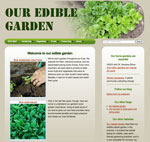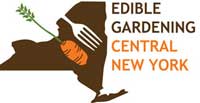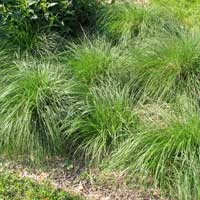Planting trees
by
Douglas Tallamy
|
 | | Red oak seedling |
| |
Some species, such as white oaks and hickories, are difficult to transplant once they reach a few feet tall and are therefore avoided by landscapers. The nice thing about plants, though, is that we can count on them to grow. Almost all of our native forest trees are easy to germinate from seed.
All over our property my wife and I have planted dozens of native trees that we started from seed. ... Within five years, our red oaks had reached six feet, as had our alternate-leaf dogwoods, gray dogwoods, and ironwood trees. ... Because these trees we started from seed and not from a whip or a pruned transplant, their shapes are terrific. Best of all, they were all absolutely free. ...
One white oak ... was two feet tall when I put it in the ground behind our new house. It is now 10 feet tall! We used to joke about having a picnic beneath it in just a few year, but the joke is on us. Soon we will spread our blanket under its branches and celebrate.
And we are not the only ones who are enjoying the white oak. The tree has already produced its first polyphemus moth, a true entomological milestone.
~ Bringing Nature Home, 2nd ed., p. 138
|
Learn by doing! Help maintain the zoo garden
|
 | | The zoo's habitat garden |
|
One of the best ways to learn anything is work alongside experts and other learners like yourself. A great way to learn more about habitat gardening and native plants is to volunteer to help maintain the habitat garden at the zoo. Contact Kate Woodle if you're interested. The "crew" meets Sundays. |
| Our Habitat Garden |  |
Visit Our Habitat Garden website for information on providing habitat, earth-friendly gardening practices, plants, and various creatures here in Central New York.
|
|
Join HGCNY!
|  |
Becoming an official member of HGCNY is easy: just join Wild Ones! When you're a Wild Ones member, you're automatically an official member of HGCNY. |
| HGCNY on Facebook |
As as more of us participate on our Facebook page, this will become a useful resource for asking (and answering!) local HGCNYers' questions about habitat gardening. |
Our Edible Garden recently updated with more resources!
|  | | Visit OurEdibleGarden.org to see an example of a Central New York edible garden, the perfect companion to your habitat garden. |
| Interested in Edible Gardening? | 
|
If you'd like to get information on Edible Gardening CNY, just email John to find out about edible gardening tours and monthly programs. Free and open to the public! |
|
Greetings!
 | | Tour a habitat garden |
Show Me, Help Me Tours
Summer is time to explore our fellow HGCNYers' gardens. We have a number of tours scheduled. They're all free and open to the public.
** JULY **
TENTATIVE Wed., July 18 at 6:00 pm: After many years abroad, Bill Wallauer, a filmmaker and conservationist with the Jane Goodall Institute, has chosen Syracuse as his home base. For the last few years, the Wallauers have been transforming a typical American yard into an urban wildlife habitat and edible garden. Their 50'x150' yard includes a woodland area with spring ephemerals, a wetland area with a pond and stream, and lots of native plants. They've already seen an increasing number of birds and other creatures visiting their habitat. Address: 253 Kensington Place in the Syracuse University area. EMAIL Bill to confirm date.Sat. July 28 at 10:00 am: We'll tour the zoo's habitat garden with Kate Woodle as our guide. This is a large garden area outside the entrance to the zoo, and many of our HGCNY members are helping maintain it. Since it is outside the gate, zoo admission is not required. ( Directions) ** AUGUST **
Sun. Aug. 5 at 8:30 am: (Note date change) We'll tour Chris's garden (I81 Cicero exit, just off Route 11). It's about a third of an acre, and she's in the process of planting it as an edible and a habitat garden. She's willing to dig herbs for people that morning! She has made a lot of progress, but could use help with native ID and would welcome ideas about what to plant. Please RSVP to Chris for directions; limited to 15 people. Sun. Aug. 19 at 2:00 pm: We'll tour Linda Rossiter's wooded property in a residential area in Fulton. It's just under a half-acre and borders a Class II wetland with stream. The gardens--including some deep shade and part-shade gardens--are being transitioned towards all native plants. Bring binoculars to view the marsh, and bring boots if you'd like to go into the marsh. Joe-pye weed, boneset, goldenrod should all be in full bloom! Linda would like help with plant ID and suggestions for new plants to add. RSVP to Linda for directions.
~ Janet Allen
|
|
|
QUIZ: Which of these is a native wildflower?
1) Daisy
2) Queen Anne's lace
3) Shooting star
4) Daffodil
5) Daylily
(The answer is at the end of this newsletter.) |
 | A pagoda dogwood about four or five years after being planted as a seedling from White Oak Nursery
|
The Advantages of Planting Small
In these days of instant gratification, it's appealing to think that we can start with a blank slate, buy an assortment of large trees and shrubs, and after a day of plopping them in holes, have a mature-looking landscape.
But there are advantages to planting smaller plants. Jim Engel of White Oak Nursery notes a few of these advantages in these excerpts from his article "The Advantages of Planting Small."
* "I have heard numerous times from customers referring to a small sized tree, 'I'll be dead before I get to enjoy this tree.' ...I say trees have as much to offer us when they are small as they do when they have reached a mature size."
 | | A pagoda dogwood a few years after being planted as a full-size tree |
* "When a small tree is planted more of the root system is retained with the plant and the root system is more in balance with the above ground portion of the tree. A good thing to remember is that any plant is only as good as its root system. ... For this reason smaller trees often catch up to and surpass the growth of trees that were planted at a larger size."
* "A group of trees in a planting can have the same or greater visual impact as one large tree and offers diverse ornamental interest. Trees can and should be planted closer together. The landscape trend should be to create plant communities using a mixture of large and small trees along with a planting of shrubs at the ground level. This is not only more interesting to look at but also provides critical habitat for birds and small mammals that is absent from most of our landscapes."
Read the whole article and other articles by Jim Engel on the White Oak Nursery website.
|
|
Featured Plant: Prairie Dropseed
 | | Dropseed in summer |
Prairie dropseed (Sporobolus heterolepsis) is a beautiful, fine-textured, easy to grow native grass. It's creates a nice border to a bed of larger plants or it can form an elegant patch of its own.
As grasses go, it's one of the shorter types growing from 1 - 3 feet tall, with each clump about 12 - 18 inches wide. It grows in sun or part-sun conditions in moist to dry, well-drained soil.
 | | Starting to grow in spring |
It's trouble-free and maintenance-free throughout the year.
In the spring, the clump sends up bits of green through the old dried out grass of the previous year.
 | | Flowering in summer |
In the summer, it forms a finely-textured mass of green, then sends up its "flower" with a pleasant scent that has been described as "buttered popcorn."
In the fall, it turns a beautiful apricot orange color. There's no need to cut back or prune the plant at the end of the season; it simply sends up new growth the following spring.
This is just one of the many, many beautiful native plants that are relatively unknown! |
|
Our Native Plant Shopping Guide tells you where to find native plants
 | |
(Click image to download)
|
To help you find native plants in CNY, we've compiled a list of plants offered by several local nurseries. REMEMBER, nurseries can sell out of any particular plant, so it's a good idea to call before setting out on your shopping trip! DOWNLOAD: This guide is available online as a free .pdf download. |
|
Answer to quiz
 | Eastern shooting star
(Dodecatheon meadia) |
The only native in the list is the exotic-looking shooting star (Dodecatheon meadia)! These beautiful flowers are described by William Cullina as "tiny umbrellas torn violently inside out by some silent tempest wind."
They're easy to grow in sun to light shade, and they appreciate moist soil.
Equally surprising is that most people's iconic wildflower--the daisy--is a Eurasian import. All the rest are of Eurasian origin, too--even the common orange roadside daylily. |
|
|
|
|